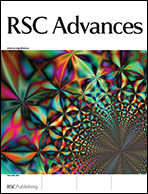Highly sensitive salicylic fluorophore for visual detection of picomole amounts of Cu2+†
Abstract
Four new fluorophores containing multiple fluorogenic branches of phenylene-ethynylene and salicylic acid Cu2+ binding sites are synthesized and evaluated as Cu2+ sensors in aqueous media. The fluorophore, F4, having a triphenylamine core and three fluorogenic branches, possesses superior sensitivity, selectivity and emission properties for fluorescence quenching detection of Cu2+. This fluorophore exhibits the highest Cu2+ quenching sensitivity in aqueous solution; Ksv = 5.79 × 106 M−1. The relatively high fluorescence emission of this fluorophore provides excellent visual contrast in a solid state paper-based sensor that enables naked eye detection of Cu2+ at the picomole level.


 Please wait while we load your content...
Please wait while we load your content...